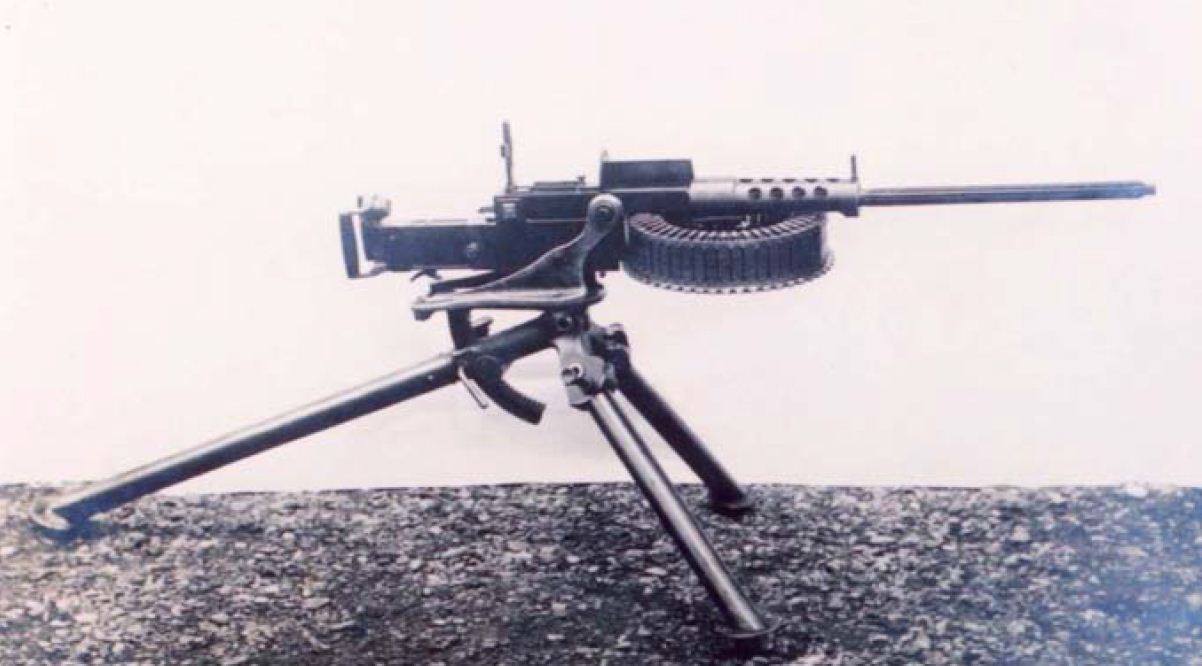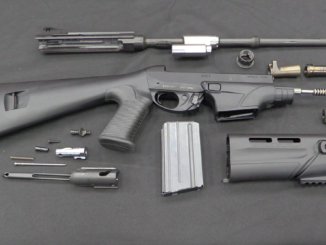Apologies; we have a pretty brief post today. I’ve been moving into a new house and things got a bit hectic. At any rate, I did happen to notice this photo from Max Popenker of an experimental magazine for the Fiat-Revelli M1914/35 machine gun:

It would appear to be an attempt to increase the potential of the gun for sustained fire, by dramatically increasing the magazine capacity and also using a heavy fluted barrel instead of the standard (and rather light) 1914/35 barrel. This carousel type magazine would probably hold something like 200 rounds – each column in it is a stack of five, and I can count almost 20 columns on this visible side. Now, the standard Fiat magazine box inserts on one side, cycles through, and is removed from the opposite side. That’s not possible with a continuous circular mag like this, and I suspect the gun was altered to allow the magazine to be loaded from the bottom. My guess is that the little tab at the front of the underside of the receiver is a release catch to allow the mag to be removed.
On a second note, thanks very much to all the folks who shared information on WWI German trench armor in the comments to Saturday’s post! I’m much obliged, and that information will be a great help in determining what exactly to do with the reproduction armor that is on its way here.




Almost looks like something that should be shooting lasers in a B grade movie
I supposed if it was used in a tank it MIGHT be a practical design, provided it worked reliably (or at all). But even then reloading looks like it could be a pain.
Still looks really cool though.
“used in a tank”
Concerning the Italian tank design, notice that Italian L3/35 tankette, Fiat M11/39 and Fiat M13/40 has double Breda machine gun (L3/35 and M13/40 – hull mounted, M11/39 – turret mounted), I suspect to overcome low practical RoF caused by low magazine capacity (24 rounds)
There could be a gap in the magazine just wide enough for the receiver. This would allow the mag to be used with standard guns. It the picture the gap would be on the far side of the gun at this point.
True, that is possible.
looks like a difficult reload.
Good luck on the move. Are you still going to be out in the desert somewhere?
Didn’t move far, just enough to necessitate picking everything up and putting it down in a new place. 🙂
Reminds me of the magazine used by the American 180-180 M2; one of my favorite designs and a pure joy to shoot. Now of they had just made a version that used the .22ccm (.22 Cooper Centerfire Magnum) … http://www.loaddata.com/members/search_detail.cfm?MetallicID=4751
The .22 CCM has been pretty much out-evolved by the FN 5.7 x28;
http://en.wikipedia.org/wiki/FN_5.7%C3%9728mm
Oddly, nobody seems to have considered putting this rimless round into a rifle, as opposed to a pistol or a PDW. In a 20″ to 22″ barrel, I suspect it would match or exceed the performance of either the .218 Bee or .22 Hornet, and feed more reliably through a box magazine than the rimmed cartridges, resulting in a good 200-yard varmint round for people who don’t fancy the turbulence of the .223, or just like relatively inexpensive short-action bolt rifles like the old Savage 340 or Remington 788.
Just a thought.
cheers
eon
“nobody seems to have considered putting this rimless round into a rifle”
Wouldn’t it be redundant to 5.7mm Johnson (also called .22 Spitfire) – .30 Carbine necked down to .224 bullet?
The 5.7 x 33 MMJ really has never gotten anywhere, which is a shame because it’s actually a pretty decent high-velocity .22 centerfire. I think the main reason is that when Melvin Johnson introduced it (in a modified M1 carbine), the whole concept of the high-velocity .22 for military/police use hadn’t caught on yet, and it didn’t have a big enough cartridge case to interest a civilian benchrest/varmint shooting market already chock-a-block with hyperactive .22 centerfires, both factory and wildcat.
The main reason I think the 5.7 x28 would have a future is that since it is now a standard round with factory ammunition, even if the manufacturers don’t come up with “purpose-built” rifle rounds for it, handloaders can do it themselves, without the necessity of making their own cartridge cases by cutting, resizing, fire-forming, etc., or having to get (expensive) semi-custom empty cases from Bell or someone similar to “roll their own”.
The thing to remember is that in terms of performance, with the right powders, it should duplicate the performance of older rounds like the .218 Bee, .22 Hornet, .22 K-Hornet, etc., out to 200 yards. And frankly, that’s about as far as most people using a varmint rifle can hit an actual “varmint”. (My personal record for a woodchuck with my father’s .22 Hornet Savage 340 was 123 yards.)
Given a decent, economy-level rifle with about a 22″ barrel and a good (about 10X) scope, the 5.7 x28 would be a good “entry-level” or “youth” varmint round. And of course, it could always be put in a semiautomatic as well, something that’s not really practical with most of the older (rimmed) “Short” .22 centerfires.
And frankly, those short rimmed rounds were more reliable feeders in tube-magazine lever-actions than they were in anything with a box magazine, due to “rim interference”. The 5.7 x28 wouldn’t have that problem.
cheers
eon
Chinn (The Machine Gun, Vol. 1, pp.361-63) notes that one version of the Fiat M/14 had a heavyweight fluted barrel to allow longer periods of (semi) sustained fire between barrel changes. The barrel on this one might be such an M/14 barrel.
He also notes that on the M/35,
This gadget might be that 300-round belt feed thingie.
Please note that the M/35 version of the Fiat-Revelli reverted to the retarded blowback action of the M/14, and as such even with a fluted chamber required lubricated cartridge cases.
Some M/35s had the old M/14 pattern oiler tank and brush in the top of the receiver, others didn’t; those that didn’t required that the cartridges be lubricated by hand during magazine loading.
If this critter fed from underneath, as seems likely from the look of it, my guess is it didn’t have the oiler “header tank”. Meaning those rounds hanging there in that feed belt or carousel or whatever were already oiled, and free to pick up whatever detritus the surroundings had to offer and take it into the chamber.
In the desert environs the Italians found themselves fighting in in North Africa, the results of oiled cartridges on their MG chambers was rather like valve-grinding compound on a drill head, in the valve seats of a ’36 Ford, when wielded by an overenthusiastic apprentice mechanic. Just with even less salutary consequences when you “stepped on the gas”.
Chinn sums up by saying,
The Fiat Model 1935 was perhaps the greatest known example of misapplied talent and inadequately tested theories in ordnance history. (p.363)
(Of course, when he wrote this in 1949 or so, he hadn’t met the M-16 yet. ;-/ )
cheers
eon
Thank goodness they didn’t persist with this Idea…I assume the Magazine was still for 6,5×52 Cartridges? (as in the original Revelli M1914?)
When they converted the 14/35, they eventually used the NEW Breda M35 Cartridge (8x59RB or 8×55 Experimental?) and a Flexible Link belt (Non-disintegrating once assembled, but manually separable on removing the cartridge…and in a 250-round Spool (I have one, full, from North Africa.)
This genial solution, unhappily, was not carried over to the Breda M37 and 38 guns (First Tray (20rnds) and second, Top feed box magazine (20 rounds)).
Wooden heads prevailed at Staff level…
Doc AV
Well, Doc, had the Italians persisted with this idea, there would be one more issue to deal with: battle-damaged ammunition magazines of this type will not feed well. Strips and box magazines are easier to replace and cost fewer man hours to manufacture. Just think of the guys who would have to lug this stuff around. The only positive feature is that the carousel would not be dropped to the ground when empty. Everything else from oiling the gun and indexing the magazine upon loading would be difficult for the Italians, especially if the British, Free-French, or the Americans got too close for comfort. Given a choice, I think the Breda 30 and the Carcano would have been slightly less dangerous to load in a desert firefight than this experimental modification of the Fiat-Revelli.
There are 5.7X28 AR uppers.
Hi Folks, this is not a Fiat 14/35 but a Fiat 14 modello aviazione, the aviation modell of WW1 without the water cooling, still chambered in 6.5×52. The experimental magazine was of 250 shots, trials were up on june 1917. It wasn’t adopted.